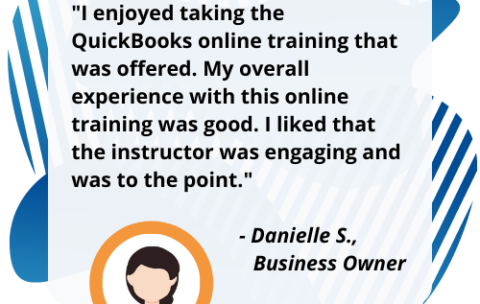Filter by Topic
Filter by Vendor
Conflict Resolution
Dive into the intricacies of workplace conflict with our comprehensive …
What you'll learn
Understand what conflict is and how it can escalate within the workplace
Identify the five most common conflict resolution styles, and when to use them
Appreciate how to deliver information positively through effective face-to-face communication skills
Establish effective techniques for timely intervention strategies
Build staff trust and morale when dealing with situations of conflict
Develop your ability to manage conflicts confidently to enhance productivity and performance
Get Smart With QuickBooks 2021 for Windows
Course Description First-time QuickBooks users will learn the basic features …
Certified SAFe® Agile Product Manager (APM)
Course Description Recognize how Continuous Exploration fuels innovation and helps …
What you'll learn
Use Design Thinking to achieve desirable, feasible, and sustainable outcomes
Explore market needs, segmentation, sizing, and competitive landscape
Manage value stream economics, including pricing and licensing
Use empathy to drive design
Apply product strategy and vision
Develop and evolve roadmaps
Execute and deliver value using SAFe
Explore innovation in the value stream
Leading SAFe 5.0 (SA)
Course Description The Scaled Agile Framework (or SAFe) is a …
What you'll learn
How to lead an enterprise Agile transformation
To apply Lean thinking techniques at the Team, Program and Portfolio levels
To apply Lean, Agile and Product Development Flow principles to improve productivity, employee engagement, time to market and quality
How to infuse Agile into your entire organization – not just your IT department
How to create Agile Release Trains that align the efforts of Agile and non-Agile teams to create greater stakeholder value
To encourage collaboration across all the layers of your organization to enable teams to deliver complex cross-functional features in 10-12 week increment
To improve the communication and focus of your organization’s Agile implementation
Prepare to take the SAFe Agilist Certification Exam
55286-A: SharePoint 2019 Power User
Course Description This course delivers the complete site owner story …
What you'll learn
Understand the benefits of using SharePoint in real world scenarios
Create new SharePoint sites to store business information
Create pages to share news and documents
Customize the structure of a site to meet specific business requirements
Create and mange view, columns and apps
Manage the security of a site
Use social tools to communicate with groups of people or the entire organization
Use search to find business information including people to documents
Describe popular reasons to use SharePoint 2019
Understand user roles in SharePoint 2019
Navigate SharePoint 2019
Manage your OneDrive and MySite
Understand the benefits of using site templates when creating new sites
Correctly use Site Collections and Sites
Control site navigation
Delete and Restore sites
Know when to create pages
Create all types of pages
Add content to a page including images and videos
Use publishing page content such as renditions and reuable content
Understand the App template available in SharePoint 2019
Create new apps to store business information
Customize apps with Columns, Views and App settings to make them relevant to specific business
Use SharePoint Apps with other Office applications including Excel and Outlook
Sort and Filter documents
Understand how to create a new approval flow
Understand how to create a new powerapp
Understand and instating a business process
Understand how to share content ina library and associated permissions
Understand how to create new permission levels and security groups
Understand how to add and remove users
Describe the key features of search
Use search to find content including people, sites and videos
Use search web parts to roll up content from multiple locations
Describe the benefits of using SharePoint social tools
Create social content including blog posts, discussions and newsfeed posts
55205-A: Mastering Microsoft Project 2016
Course Description: This three-day, instructor-led course is intended for individuals …
What you'll learn
Understand the discipline of project management as it applies to using Microsoft Project 2016.
Create a Work Breakdown Structure.
Identify Task Types & Relationships.
Define Resources within Project.
Make Work Package Estimates.
Create an Initial Schedule.
Create a Resource Leveled Schedule.
Create Projects from templates, Excel files.
Create Global templates.
Create formulas and graphical indicators.
The steps to record a macro.
Format Output and Print Reports.
Integrate Multiple Projects.
Set up a Project with a Calendar, Start date, and scheduling method.
Understand Manually Schedule vs. Auto Schedule.
Manage multiple projects.
Be able to create a master project list with shared resources.
Have a fundamental understanding of how Microsoft Project will help them track their projects.
Understand what is new in Project 2016 and how it will increase their productivity.
Learn how the ribbon will help them get the most of out of this productivity tool.
Learn how to quickly change views and see what is going on with their projects.
Understand the 5 essential steps in building a successful project plan.
Prepare a new project plan and set the date and other basic information.
Enter detailed project information.
Understand how to sequence tasks.
Understand and define basic resource types.
Assign resources to tasks.
Understand the benefits of baselining a project or specific tasks.
Understand the basics of how to track project progress.
Create a new project using a template, Excel, a SharePoint Tasks List or a new Project file.
Establish one or more calendars to constrain resource availability.
Configure Microsoft Project to calculate the schedule from the Start Date forward or from the Finish Date backward.
Understand how to turn on Manually Schedule and Auto Schedule.
Understand when to use Manually Schedule.
Understand the limitations of Manually Scheduling.
Build and use summary and subordinate tasks.
Understand and use milestones.
How to organize the WBS.
How to format the WBS.
Develop WBS outlines.
Assign completion criteria.
Evaluate the WBS.
Understand and use WBS outlines.
Understand how to link Project artifacts to their projects.
Understand how to create notes on tasks.
Understand the different types of task relationships.
Understand and use various methods to create relationships.
Determine and display task sequence.
Understand how to use Lag, Lead and Delay.
Define the different types of resources.
Define individual resources that will be used on the project.
Record the cost(s) of using each type of resource.
Record the limit of availability for each type of resource by establishing a resource calendar and defining the maximum units of that resource.
Assign values for resources, duration and work.
Understand task types.
Understand Effort Driven scheduling.
Understand material resources and their costs to a project plan.
Identify the critical path.
Understand difference between slack and slippage.
Calculate float.
How to leverage constraints.
How to get the benefit from the Task Inspector, and the impact of changes on a project schedule.
Adjust a project schedule to account for limited resources.
View the overall cost and schedule of a project.
Identify resources that are over- allocated for a project schedule.
Use multiple ways to adjust tasks and assignments to remove over- allocation for any resource.
Set a baseline.
Enter and manage project performance data.
Pick a tracking method.
Perform variance analysis.
Sync Projects results with SharePoint.
Create standardized views, with the power of sorting, filtering and grouping.
Customize a variety of standard reports.
Learn how to use Visual Reports.
Export reports in a variety of formats.
Use common resources among multiple projects.
Link tasks between multiple projects.
Create a consolidated view of multiple projects and shared resources.
Take advantage of the advance features of Microsoft Project.
Be able to create a Macro.
Share common settings among all future projects.
55232-A: Writing Analytical Queries for Business Intelligence
Course Description: This three-day instructor led course is about writing …
What you'll learn
Identify independent and dependent variables and measurement levels in their own analytical work scenarios.
Identify variables of interest in relational database tables.
Choose a data aggregation level and data set design appropriate for the intended analysis and tool.
Use TSQL SELECT queries to produce ready-to-use data sets for analysis in tools such as PowerBI, SQL Server Reporting Services, Excel, R, SAS, SPSS, and others.
Create stored procedures, views, and functions to modularize data retrieval code.
Describe the purpose of analytical queries
Describe the function of TSQL data retrieval in an analytics/business intelligence environment
Describe the primary functions of the database engine
Discuss TSQL as a declarative language
Identify variables of interest in database tables
Write basic SELECT queries
Implement column expressions in SELECT queries
Implement column and table aliases
Describe data types and Implement data type conversions
Implement built-in functions
Use WHERE and ORDER BY clauses in SELECT queries
Discuss and describe the conceptual flow of JOIN operations
Implement INNER and OUTER JOIN operations on two or more tables
Describe the order of operations of SELECT clauses
Combine JOIN operations with WHERE and ORDER BY
Describe the row granularity of result sets
Discuss and implement aggregate functions to achieve required row granularity
Use GROUP BY to calculate aggregate values for groups
Use HAVING to filter records in the result set by aggregate value
Combine GROUP BY and HAVING with WHERE and ORDER BY
Describe and discuss the rationale of creating intermediate results sets within SELECT queries
Implement non-correlated and correlated subqueries
Implement derived tables
Implement Common Table Expressions
Create intermediate to advanced TSQL queries to retrieve result sets for analysis
Identify scenarios in which views, table-valued functions, and stored procedures simply data retrieval
Compare and contrast views, table-valued functions, and stored procedures
Create views, table-valued functions, and stored procedures
Describe the security requirement for creating database objects
Implement views, table-valued functions, and stored procedures for users with read-only access to source data
Describe the properties of database connection strings
Run queries from, and return results to, Excel, PowerBI, and RStudio
Export query results to external text files using the SSMS results pane, the bcp utility, and the Import/Export Wizard
MS-700T00-A: Managing Microsoft Teams
Course Description: The Managing Microsoft Teams course is designed for …
What you'll learn
Understand the discipline of project management as it applies to using Microsoft Project 2013.
Create a Work Breakdown Structure.
Identify Task Types & Relationships.
Define Resources within Project.
Make Work Package Estimates.
Create an Initial Schedule.
Create a Resource Leveled Schedule.
Create Projects from templates, Excel files.
Create Global templates.
Create formulas and graphical indicators.
The steps to record a macro.
Format Output and Print Reports.
Integrate Multiple Projects.
Set up a Project with a Calendar, Start date, and scheduling method.
Understand Manually Schedule vs. Auto Schedule.
Manage multiple projects.
Be able to create a master project list with shared resources.
Have a fundamental understanding of how Microsoft Project will help them track their projects.
Understand what is new in Project 2013 and how it will increase their productivity.
Learn how the ribbon will help them get the most of out of this productivity tool.
Learn how to quickly change views and see what is going on with their projects.
Understand the 5 essential steps in building a successful project plan.
Prepare a new project plan and set the date and other basic information.
Enter detailed project information.
Understand how to sequence tasks.
Understand and define basic resource types.
Assign resources to tasks.
Understand the benefits of baselining a project or specific tasks.
Understand the basics of how to track project progress.
Create a new project using a template, Excel, a SharePoint Tasks List or a new Project file.
Establish one or more calendars to constrain resource availability.
Configure Microsoft Project to calculate the schedule from the Start Date forward or from the Finish Date backward.
Understand how to turn on Manually Schedule and Auto Schedule.
Understand when to use Manually Schedule.
Understand the limitations of Manually Scheduling.
Build and use summary and subordinate tasks.
Understand and use milestones.
How to organize the WBS.
How to format the WBS.
Develop WBS outlines.
Assign completion criteria.
Evaluate the WBS.
Understand and use WBS outlines.
Understand how to link Project artifacts to their projects.
Understand how to create notes on tasks.
Understand the different types of task relationships.
Understand and use various methods to create relationships.
Determine and display task sequence.
Understand how to use Lag, Lead and Delay.
Define the different types of resources.
Define individual resources that will be used on the project.
Record the cost(s) of using each type of resource.
Record the limit of availability for each type of resource by establishing a resource calendar and defining the maximum units of that resource.
Assign values for resources, duration and work.
Understand task types.
Understand Effort Driven scheduling.
Understand material resources and their costs to a project plan.
Identify the critical path.
Understand difference between slack and slippage.
Calculate float.
How to leverage constraints.
How to get the benefit from the Task Inspector, and the impact of changes on a project schedule.
Adjust a project schedule to account for limited resources.
View the overall cost and schedule of a project.
Identify resources that are over- allocated for a project schedule.
Use multiple ways to adjust tasks and assignments to remove over- allocation for any resource.
Set a baseline.
Enter and manage project performance data.
Pick a tracking method.
Perform variance analysis.
Sync Projects results with SharePoint.
Create standardized views, with the power of sorting, filtering and grouping.
Customize a variety of standard reports.
Learn how to use Visual Reports.
Export reports in a variety of formats.
Use common resources among multiple projects.
Link tasks between multiple projects.
Create a consolidated view of multiple projects and shared resources.
Take advantage of the advance features of Microsoft Project 2013.
Be able to create a Macro.
Share common settings among all future projects.










